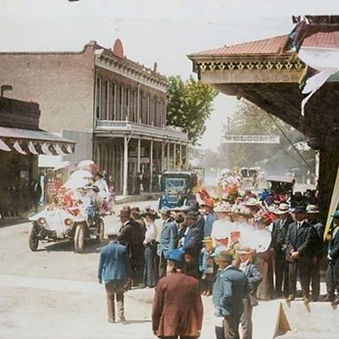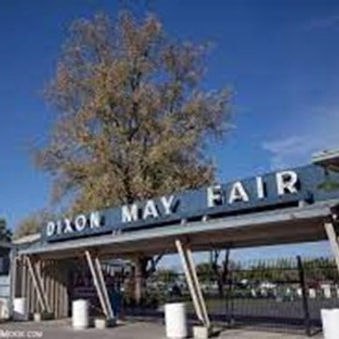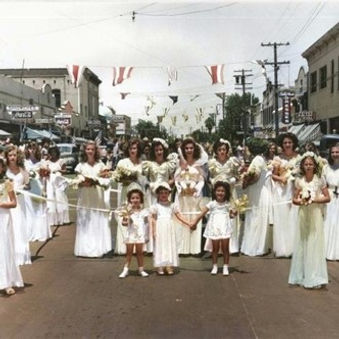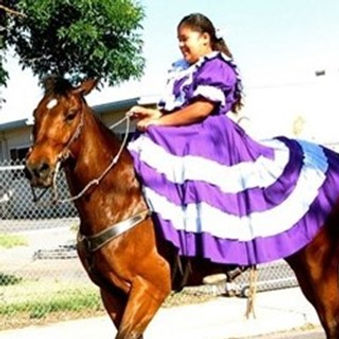Dixon May Fair & Parades

May Fair Parade – Old Corner – North 1st and West B Streets – Looking West – 1915
This picture shows a view of North 1st and West B Streets, looking West toward the railroad tracks. This was a May Fair Parade in 1915. On the south side of the street was the First National Bank and Opera House. On the north side of the street was Schulze’s General Mercantile which is today Cynde’s Place. The Dixon May Fair began in 1875 and is the longest running parade in California.

Dixon May Fair, South First Street - since 1875
The first May Fair was held in 1875 and was a giant picnic for the town. The Dixon May Fair (and parade) is one of the longest running fairs in the State of California, and Dixon hosts many other festivals, all of which bring visitors from both near and far. For a while, Dixon had the best and most famous dirt horse-racing track in California, which was located where the Dixon May Fair is held today. Bicycle racing also became a sport of interest and races were held at the fairground tracks from 1895-1910. Since 1875, parades have included highly decorated floats, cars, horses, and marching bands. Other traditions included the selection of the May Fair Queen, and maypole dance.

May Day Parade – Southeast Corner of 1st and A Streets – 1960
The May Day Parade, now called the Dixon May Fair Parade, is one of the longest running parades in the state of California. The parade and May Fair began in 1875. This is a picture of the Rainbow Girls float in 1960. The writing on the float says, “Rainbow Frontiers”. The photo was taken in 1960 by Jerry Fielder, father of Worthy Advisor Pady Fielder, at the top of the float. Jerry Fielder was California's Secretary of Agriculture under Governor Ronald Reagan in 1972. Other members are Betty Wolfe, Diane Lewis, Judy Greenwood, Fay Wallace, Pat Lynch, Kay Yates, and Dianne Bryant. They held the offices of Associate Worthy Advisor, Charity, Hope, Faith, Recorder, Treasurer and Chaplain. Rainbow Girls is a Masonic youth service organization for young ladies between the ages of 13-21. They are taught leadership training through community service, confidence, and citizenship. Installation of officers is held quarterly. Each of the seven colors represents a different station: Red/love, orange/religion, yellow/nature, green/immortality, blue/fidelity, indigo/patriotism, and violet/service.

Portuguese Holy Ghost Festival – First and A Streets – 1947
The Portuguese Holy Ghost Festival is usually held on the 7th Sunday after Easter (Pentecost Sunday). Queen Marie Sequeira and her attendants are participating in this 1947 Festival. It was an all-day event which began with a parade and ended at the fairgrounds with a barbeque. First Row from left to right: Carlene Fanning, Carol Torchia, Patty Sequeira, Betty Torchia, and Carolyn Fanning. Second Row from left to right (just behind the ribbon): Faye Crawford, Bonnie Shost, Arvana Asay, Florence Brazil, Marie Sequeira (Queen), Alice Misuraca, unknown, Barbara Johnson, and Jean Pardi. Third Row on the left is Patricia Crockett Conley, and behind her is Rhoda Covington Bruett.

Las Charras in the Dixon May Fair Parade – 2000s
Las Charras (Mexican cowgirls) participated in the annual Dixon May Fair Parade. The first May Fair was held in 1875 and was originally a giant picnic for the town. The Dixon May Fair (and parade) is one of the longest running fairs in the State of California, and Dixon hosts many other festivals, all of which bring visitors from both near and far. The Latino population has grown significantly in Dixon since the 1940s when farmers had access to the Bracero Program, many of its participants settled in Dixon to raise their families. The second important event was the building of the Dixon Migrant Camp, which was originally built and opened in 1967 and was located on Pedrick Road. It was relocated in 1984 to its current location on Radio Station Road. It provides housing and childcare services from April to November to seasonal farm workers and their families. These families migrate seasonally from Mexico or other parts of the United States, to work on Dixon farms. Some of these families have also chosen to remain and become part of the Dixon community.

